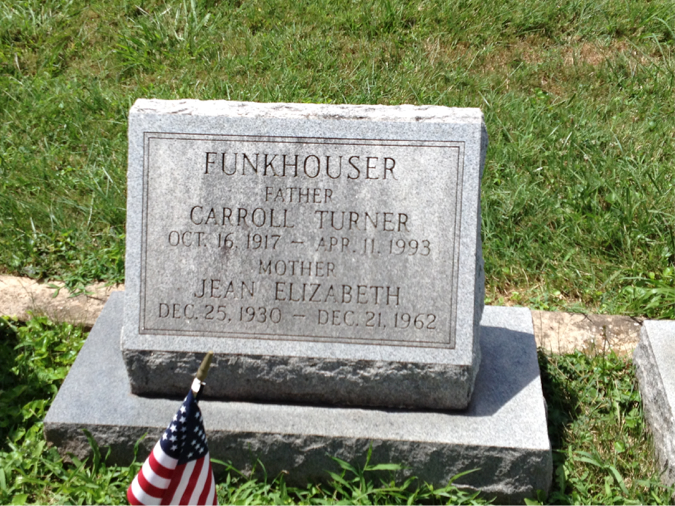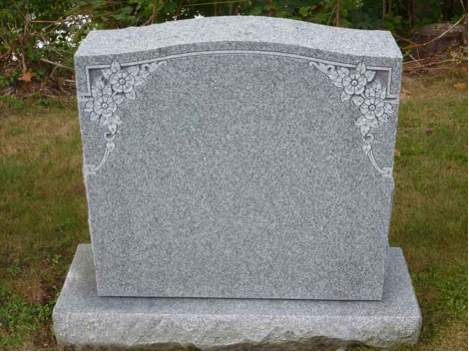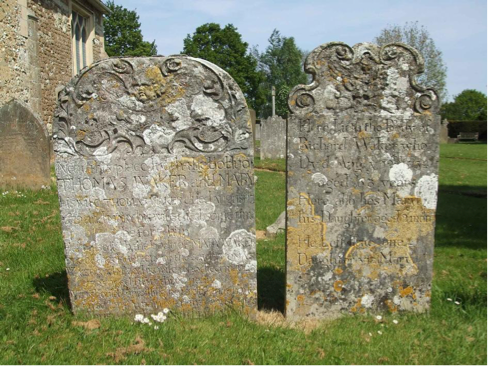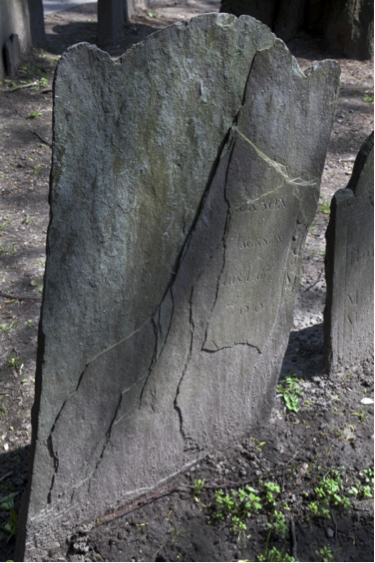Welcome to Dr. Funkhouser’s Resting Geology!

Geocaching takes us to a lot of places for a multitude of reasons. Today I am bringing you to a well cared for, if often not visited cemetery in the heart of Manassas, Virginia. Hold on to your boots, this may be a spooky visit!
There will be different types of tombstones to view in this cemetery, some date back to the turn of the 20th century, some farther back still.
I’d like to share some information on the types of headstones you will see in this cemetery, and other cemeteries.
FIELDSTONES- The earliest markers for graves were natural fieldstone, some unmarked and others decorated or incised using a metal awl. Typical motifs for the carving included a symbol and the deceased's name and age.
An example of fieldstones is below.

GRANITE- A hard stone and requires skill to carve by hand. Modern methods of carving include using computer-controlled rotary bits and sandblasting over a rubber stencil. Leaving the letters, numbers and emblems exposed on the stone, the blaster can create virtually any kind of artwork or epitaph.
Granite is a light-colored igneous rock with grains large enough to be visible with the naked eye.
It forms from the slow crystallization of magma below Earth's surface. Granite is composed mainly of quartz and feldspar with minor amounts of mica, amphiboles, and other minerals. This mineral composition usually gives granite a red, pink, gray, or white color with dark mineral grains visible throughout the rock.
An example of a granite headstone is below.

MARBLE AND LIMESTONE- Both limestone and marble take carving well. Marble is a recrystallized form of limestone. The mild acid in rainwater can slowly dissolve marble and limestone over time, which can make inscriptions unreadable. Portland stone was a type of limestone commonly used in England—after weathering, fossiliferous deposits tend to appear on the surface. Marble became popular from the early 19th century, though its extra cost limited its appeal.
Marble is a metamorphic rock that forms when limestone is subjected to the heat and pressure of metamorphism.
It is composed primarily of the mineral calcite (CaCO3) and usually contains other minerals, such as clay minerals, micas, quartz, pyrite, iron oxides, and graphite. Under the conditions of metamorphism, the calcite in the limestone recrystallizes to form a rock that is a mass of interlocking calcite crystals. A related rock, dolomitic marble, is produced when dolostone is subjected to heat and pressure.
Limestone is a sedimentary rock composed largely of the minerals calcite and aragonite, which are different crystal forms of calcium carbonate (CaCO3). Most limestone is composed of skeletal fragments of marine organisms such as coral, forams and molluscs.
An example of a marble headstone is below.

An example of a limestone headstone is below.

SANDSTONE- Sandstone is durable, yet soft enough to carve easily. Some sandstone markers are so well preserved that individual chisel marks are discernible, while others have delaminated and crumbled to dust. Delamination occurs when moisture gets between the layers of the sandstone. As it freezes and expands the layers flake off. In the 17th century, sandstone replaced fieldstones in Colonial America. Yorkstone was a common sandstone material used in England.
Sandstone (sometimes known as arenite) is a clastic sedimentary rock composed mainly of sand-sized minerals or rock grains.
Most sandstone is composed of quartz and/or feldspar because these are the most common minerals in the Earth's crust. Like sand, sandstone may be any color, but the most common colors are tan, brown, yellow, red, gray, pink, white and black. Since sandstone beds often form highly visible cliffs and other topographic features, certain colors of sandstone have been strongly identified with certain regions.
An example of a weathered sandstone headstone is below.

SLATE- Slate can have a pleasing texture but is slightly porous and prone to delamination. It takes lettering well, often highlighted with white paint or gilding.
Slate is a fine-grained, foliate metamorphic rock that is created by the alteration of shale or mudstone by low-grade regional metamorphism.
It is popular for a wide variety of uses such as roofing, flooring, and flagging because of its durability and attractive appearance.
Slate is composed mainly of clay minerals or micas, depending upon the degree of metamorphism to which it has been subjected. The original clay minerals in shale alter to micas with increasing levels of heat and pressure. Slate can also contain abundant quartz and small amounts of feldspar, calcite, pyrite, hematite, and other minerals.
An example of a slate headstone is below.

But what happened to them!?! You will notice that some of the headstones are no longer showing their motifs, much less their name and life dates. Weathering occurs in a few ways and I’ll briefly go over some of them.
Weathering:
Weathering is the breakdown of rocks via the environment. Weathering can happen in 3 different ways:
1. Chemical weathering – Chemical reactions break down the bonds holding the rocks together, causing them to fall apart, forming smaller and smaller pieces. Chemical weathering is much more common in locations where there is a lot of water. This is because water is important to many of the chemical reactions that can take place. Warmer temperatures are also more friendly to chemical weathering. The most common types of chemical weathering are oxidation, hydrolysis and carbonation.
2. Mechanical weathering - Takes place when rocks are broken down without any change in the chemical nature of the rocks. The rocks are essentially torn apart by physical force, rather than by chemical breakdown. The forces that break rocks down can be numerous, and include such things as pent up energy as the Earth’s crust slowly moves. When great amounts of pressure build up, the resulting mechanical effect can be that very large joints, or faults are created.
The most common type of mechanical weathering is the constant freezing, and thawing of water. In liquid form, water is able to penetrate the many holes, joints, and fissures within a rock. As the temperature drops below 32 ° F, this water freezes. As water freezes, it expands, becoming about 10% larger than it was in liquid form. The result is that the holes and cracks in rocks are pushed outward. Even the strongest rocks are no match for this force.
3. Biological weathering – The word ‘bio’ means life. Thus biotic weathering is any type of weathering that is caused by living organisms. Most often the culprit of biotic weathering are plant roots (from lichen, moss etc). These roots can extend downward, deep into rock cracks in search of water, and nutrients. In the process they act as a wedge, widening and extending the cracks.
TO CLAIM THIS CACHE PLEASE MESSAGE ME WITH ANSWERS TO THE FOLLOWING. Do not post any answers in your log.
To Qualify for this cache, please send the following answers to my Message Inbox or email.
Stage 1: N38° 44.994, W077° 28.833
1. Find the tallest monument in the Confederate Cemetery
- a. What type of stone and color do you think this is?
- b. Is there evidence of weathering damage to this monument? If so, based on the information above, what kind of weathering do you think has occurred? If not, what characteristics do you think have prevented weathering damage?

Stage 2: N38° 44.994 , W077° 28.828
2. Find Mr. Portner's tall Obelisk
- a. What type of stone is the obelisk?
- b. Based on the other headstones in this gated area, do you believe this obelisk was placed here as the first marker or more recently? Use what you’ve learned about weathering to support your opinion.
Stage 3: N38° 44.986, W077° 28.816
3. Find the headstone that looks very out of place
- a. There are two different, yet distinct types of weathering here. What are those kinds? Why do you think this type of material is more susceptible to weathering identification then other stones in the cemetery?
Stage 4: N38° 45.001, W077° 28.776
4. Find the mausoleum with the 10 letter word at the top
- a. What is the material that makes up the majority of this mausoleum?
- b. Please explain based on your knowledge of weathering why the condition of the mausoleum is so pristine.
- c. What is the grain size and color of the stone? What does the grain size tell you about the conditions that the stone was formed in?
Stage 5: N38° 45.050, W077° 28.804
5. Find the tri-color obelisk and identify the 3 colors and what type of stone each level is made of.
6. Nearby there are several markers. Find a granite marker and a limestone marker from the 1850-1900 era, compare and contrast their weathering – what is similar, what is different. Given what you have learned about these stones, what type of weathering do you think the stones have experienced?
only necessary if you are participating in the 2016 NOVAGO Murder Mystery Series (below)
*POKE* one last thought, before you leave the cemetery.... make sure to capture the name on the mausoleum at stage 4. Something tells me a stealthy character has been doing some mysterious things around NoVAGO.... keep your eyes peeled
CONGRATULATIONS TO CHASE CLAN 2.3 FOR THE FTF!!!

Best Earthcache AND Most Outstanding Location/Scenery
![]()

BEST EARTHCACHE